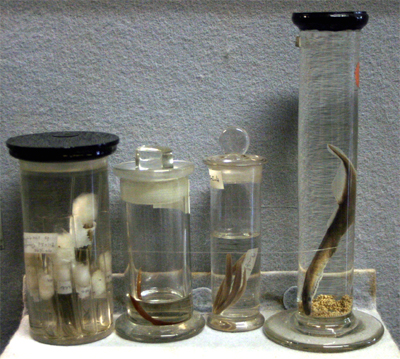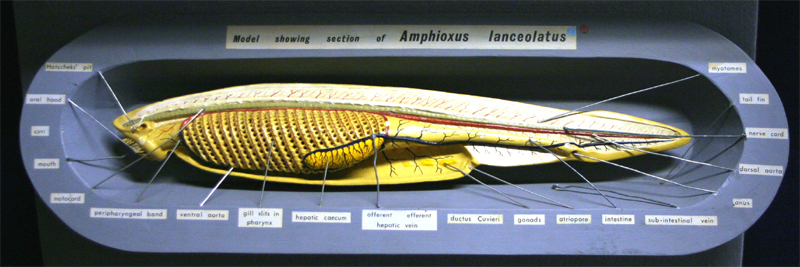
SUBPHYLUM CEPHALOCHORDATA | |
Members of the subphylum Cephalochordata lack a backbone but possess the three features that distinguish the Phylum Chordata from all other phyla: a notochord; a dorsal, hollow nerve cord; pharyngeal clefts. Lancelets are small marine creatures, which spend most of their lives buried tail first in the sand in shallow waters, with only the anterior end exposed. The body is typically fish-like in shape, translucent and about 5 cm. The most studied genus is Branchiostoma or Amphioxus. John Goodsir first described its anatomy in detail from two specimens dredged up by his friend Edward Forbes from a sandbank on the East Coast of the Isle of Man, Forbes’ home. 
Origin of the Vertebrate ChordatesThere are two theories as to the origin of the vertebrates: both suggest they evolved from a filter feeding animal with gill slits. The first theory based on fossil evidence suggests that modern Urochordates, including sea-squirts, Cephalochordates and Vertebrates, descended from a common free-swimming ancestor resembling a lancelet. This theory suggests a direct link from lancelet-like creatures living some 550 million years ago (mya) to the fore-bears of recent lampreys, living some 500 mya, and hence to proto-fish, ancestors of modern fish. Proto-fish were jawless animals with gills, which sucked in food from the sea floor rather like a vacuum cleaner. Modern lampreys are very similar to proto-fish but have adopted a parasitic mode of life attached to and feeding on the outside of true fish. The other theory suggests that both lancelets and vertebrates evolved form the motile, larval stage of a common sessile ancestor, like a sea-squirt. According to this theory the larval stages would have developed in importance and duration until it could reproduce sexually. The sessile adult stage would have then disappeared from the life-cycle. |
|
Model of AmphioxusThis model shows the structure of Amphioxus, including the well-developed nerve cord, notochord and large pharynx perforated with gill slits for filter feeding. Water is taken in through the fringed mouth, passes through the gill slits into the atrium and out through the atrial pore. Food particles are strained out by the pharynx and passed back into the intestine, as in ascidians. Oxygen is absorbed from the water as it passes through the gills.  |
|






